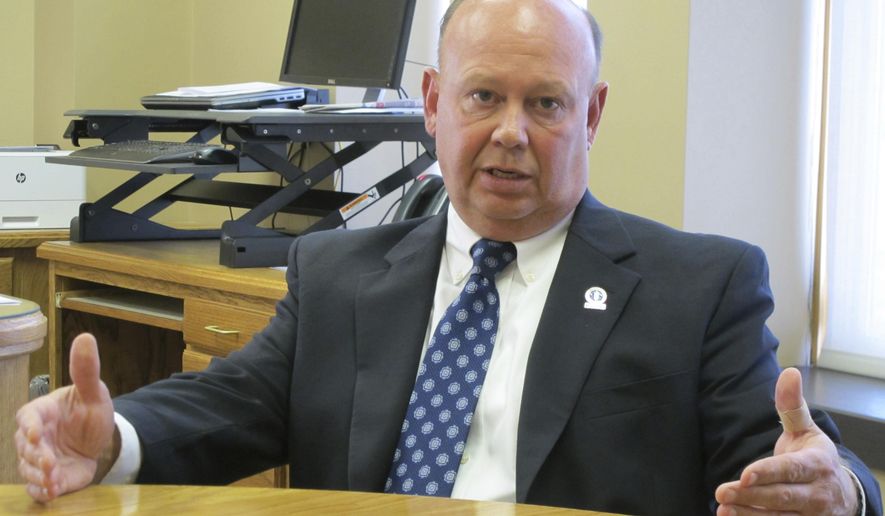TOPEKA, Kan. (AP) - Kansas’ top prison official says protests outside the walls are helping to fuel unrest in state prisons by inspiring inmates to use mass demonstrations to air grievances and he doesn’t see any other connection between a this week’s uprising at one prison and disturbances earlier this summer at another.
Some legislators are skeptical and likely to press Corrections Secretary Joe Norwood for more information about Tuesday night’s uprising at the Norton Correctional Facility in northwestern Kansas.
Norwood said in an Associated Press interview that the Norton disturbance appeared to be “spontaneous.” Inmates set small fires and smashed windows and, according to part of a log obtained by AP, threw rocks, tried to run over a captain with a cart and were told they faced lethal force if they didn’t comply with commands.
Norwood said the unrest was a “real anomaly” for the Norton prison, which houses minimum- and “low” medium-security inmates. The Department of Corrections described it as a disturbance, though Norwood told The Associated Press “in my opinion, disturbance and riot are really synonymous.”
The Norton riot came after three disturbances in May and June at the state’s maximum-security prison in El Dorado. Also, Norwood said the department plans to prosecute an inmate for battering an officer at a maximum-security prison in Hutchinson this week.
“We see, even in the communities, there’s more of a propensity for citizens to object to things more in a group-style setting and air grievances through protesting,” he said. “I think we’re seeing some of that bleed over into the inmate population.”
Several legislators argued that inmate transfers or increased double-bunking at El Dorado and Norton contributed to the unrest. State Sen. Laura Kelly, a Topeka Democrat, said Norwood’s comments showed “the department is not taking any responsibility for the problems at hand.”
Legislators already were preparing to order an audit of the El Dorado disturbances, and at least two legislative committees expect to discuss the unrest at meetings later this fall.
“Sometimes you may have to make a decision that we need to change our management,” said Senate Ways and Means Committee Chairwoman Carolyn McGinn, a Sedgwick Republican.
Kansas is hardly alone in experience prison unrest. Since the start of the year, there have been disturbances in state or federal prisons in at least 10 other states, including Arizona, Florida, Iowa, Massachusetts and Michigan. An officer died in a February uprising in Delaware.
David Fathi, director of the American Civil Liberties Union’s National Prison Project, said the causes of unrest are typically “prison-specific.” He said inmates don’t resort to mass protest lightly because they face discipline even if they are peaceful in airing a grievance.
“It’s almost always something very concrete,” he said.
Norwood noted that inmates have televisions in day rooms, and some can buy them for their cells.
“They see the incidents in the community, the protesting in the community, and perceive that as a potential means to address their grievances or concerns,” he said.
Kansas legislators saw high turnover among corrections officers as a key factor in the disturbances at the El Dorado prison and pressured Republican Gov. Sam Brownback into ordering immediate pay raises last month for uniformed officers to help fill vacancies.
The annual turnover rate among uniformed officers statewide is 33 percent and 46 percent at El Dorado. As of last week, the department said, 87 of 360 uniformed-officer positions at El Dorado were open, or 24 percent.
Norwood had attributed some unrest at the El Dorado prison, about 30 miles (48 kilometers) northeast of Wichita, to unhappiness among inmates transferred from other prisons.
But he said such discontent wasn’t behind the riot at the Norton prison, about 320 miles (515 kilometers) west of Kansas City and just south of the Nebraska border. Norton has a low employee turnover rate, with only 17 of 196 uniformed-officer positions vacant, or 8.7 percent.
After the Norton riot, the department transferred 100 of the prison’s 856 inmates to other facilities because of their behavior during the riot. Part of one housing unit was not livable, but the department said the inmates were transferred for security reasons, and Norwood said he expects the space to be back in use next week.
The department said the riot began when an inmate or inmates set fire to a mattress in a housing unit and about 250 spilled into the yard. The emergency log said some inmates wrapped large pieces of glass in towels as possible weapons.
Norwood said when the unrest was contained, between 30 and 50 inmates were still participating as the temperature dipped into the 40s.
“A lot of them didn’t have jackets on, so that would indicate that they weren’t planning on being outside for an extended period of time, so it was not a coordinated activity,” he said.
___
Follow John Hanna on Twitter at https://twitter.com/apjdhanna .




Please read our comment policy before commenting.